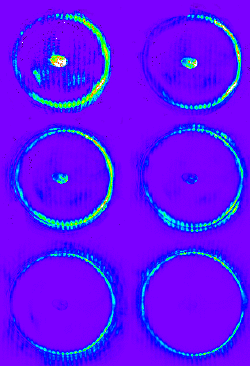A Cone of Coherent Light

Lasers come in infrared and visible varieties, but none yet in the x-ray band. A compact and powerful source of coherent x rays is the dream of many physicists, who see applications such as making atomic scale, three-dimensional movies of a melting crystal or an operating photosynthesis protein. In a step toward that goal, a research team has detected high frequency coherent light generated by a new process. As they report in the 12 June PRL, intense laser pulses can stimulate free electrons in a plasma to emit coherent light at triple the input frequency in a narrowly-directed cone. The authors say that much higher frequencies should be possible in the future, but their other goal is to learn more about the poorly understood interactions between light and electrons under these extreme conditions.
Zap an electron with a normal laser pulse, and the light will scatter essentially unchanged. But if the light is intense enough to accelerate the electron close to the speed of light with each cycle–the relativistic regime–“you get all kinds of interesting phenomena,” says Donald Umstadter of the University of Michigan in Ann Arbor. He and his colleagues reached that milestone two years ago when they blasted a gas with a laser at one frequency and detected other frequencies (harmonics) in the scattered light. The harmonic frequencies are integer multiples of the input laser frequency, and their appearance is a classic sign of so-called nonlinear scattering processes.
Although harmonic generation has been studied for many years, in most other experiments the electrons are bound to atoms, and the combined field of the nucleus and the laser leads to the nonlinearity. In the Michigan team’s work, the gas is first ionized, so the harmonics are emitted by free electrons. When these electrons are accelerated close to the speed of light, the laser’s magnetic field becomes just as influential as its electric field, so the electrons travel in figure-eight patterns while emitting harmonics in specific angular patterns.
In their latest work, Umstadter and his colleagues sent two 400 fs long, 1053 nm wavelength pulses (with intensity 1017 W/cm2) through a gas of hydrogen or helium–the first pulse to ionize the atoms, the second to generate the harmonics. They detected a “phase-matched” third harmonic at 351 nm, which was emitted with high efficiency in a tight cone of coherent light.
Previously they looked at large scattering angles and saw only incoherent harmonics. “No theory predicted the phase-matching angle,” says Umstadter, so “looking in the forward direction was just an educated guess.” Their theory proposes that the third harmonic light propagates slightly slower through the gas than the incident light, so with an angle of 6 degrees between them, the two light waves are in phase, and the emission from each electron in the plasma is synchronized. The theory predicts that higher harmonic light produced this way should be even more intense than the lower harmonics, unlike conventional harmonic generation, where the lowest harmonics are the strongest.
“It’s beautiful work,” says Alex Gaeta of Cornell University. He says it’s a convincing demonstration of relativistic effects that had been predicted for many years, but only recently became possible experimentally. The phase matching effect is just one of the many issues that need to be fully understood before coherent x rays can be produced relativistically, Gaeta says.


